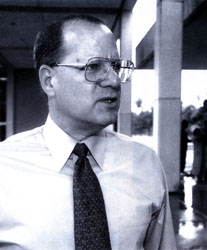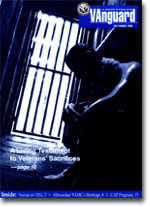
The Transforming Power Of 'Visualizing' Your Mission
VAnguard - July 2002 - By Stewart Liff
We've come a long way at the Los Angeles VA Regional Office. There was a time when we had lost sight of both the veterans and the mission. In VA's first customer satisfaction survey, we ranked last out of 58 regional offices. The Department seriously considered closing our office or moving it to a different city. We needed a major makeover.
A concept I call visual communication has helped us achieve a remarkable turnaround. It involves a "whole brain" approach to communication. We use images to create an emotional response in the right side of the brain, the creative side. At the same time, we supply meaningful data and figures to stimulate the brain's left side.
Images can evoke powerful emotional responses. They can be linked to a point in time. They can grab our attention, influence our thoughts and shape our perceptions. Yet, despite their effect, managers generally rely on written words to convey important organizational information.
I've learned that this just doesn't work - people don't pay attention to the words on vision statements, strategic plans, and balanced score cards if they're not visually linked to the mission.
One of the first actions I took when I arrived in Los Angeles in 1994 was to create a roadmap that laid out visually the different steps we were going to take to reach our goals of becoming a world-class organization. We wanted to become a place where people are proud to come to work, where they feel a connection to the mission and can clearly see how their work impacts people's lives.
We started with the basics, the physical layout. Our office is housed in a beautiful building right next to UCLA, but through years of neglect, it had become a mess. Half the lights had been turned off because of the oil embargo in the 1970s and had never been turned back on. Carpets were held together by masking tape. Our work groups were crushed together on one half of the office and a row of file cabinets blocked one of the best views in Southern California.
The first thing we did was reconfigure the office space. We put the file cabinets in the middle, creating teams on either side. This arrangement reduced the amount of socializing and wandering around, and within one month, our productivity increased by 8 percent. We turned on the lights, replaced the carpets and painted the file cabinets. These physical changes had a major impact on attitudes and morale.
This article was featured in VAnguard. With our office looking more respectable, employees felt better about themselves and their jobs and they began dressing and acting more professionally. But to visitors, our office still looked like a typical government agency. We wanted our work environment to live and breathe our mission. We wanted veterans and their families to know instantly that we were here to serve them, that we respected their service to our country, and that we were going to try our best to grant their claims for benefits.
Using images, objects, colors, sounds and environmental surroundings, we have transformed the entire regional office into a veterans museum. Along the way, we've reconnected with the VA mission and made tremendous improvements in how we serve southern Californian veterans.
Our turnaround was made possible only through the drive and commitment of our employees. They made it possible by believing in themselves and taking pride in our mission. They are integral to our success and it's a privilege to work by their sides.
We no longer look or operate like any other government office. And people are starting to notice. More than 50 private and public organizations have visited our office over the past two years to study our transformation and learn about the visual communication approach.
Veterans have noticed as well. From their perspective, we used to grant 33 percent fewer claims than the typical VA regional office. Today, our claims processing customer satisfaction ratings, which were once the lowest in the nation, are well above the national average. And we increased the number of veterans rehabilitated by more than 500 percent, jumping from 59 in 1994 to 376 last year. We achieved these results even as our staffing level dropped 37 percent.
Last year, we were on of two recipients of the Office of Personnel Management's PILLAR Award for aligning employee performance goals with our strategic plan and linking incentives to customer service results. Take a look around your organization. Can you see your mission? Is it readily understandable, easily absorbed? If not, then the visual communication model may be for you. It's a program that can be replicated anywhere; the only limit is your imagination.


